Do you want to become a versatile and skilled graphic designer?
This is a comprehensive article on the best graphic design certification courses.
These courses prepare you for a career as a graphic designer.
These courses prepare you for a career as a graphic designer. Most of the courses in the list are individual zero-to-hero courses. But some of the courses in this list are specialization programs for serious learners. These programs consist of multiple courses.
Whether you choose a specialization program or a single course, you get a certification for completion. In addition, you get some awesome projects in your portfolio.
This article has affiliate links at no cost to you!
Best Graphic Design Courses
Here is a quick list of the best graphic design courses.
You can find a thorough description of each course by clicking the links to the courses.
- Graphic Design Masterclass – Learn GREAT Design
- Graphic Design Bootcamp: Photoshop, Illustrator, InDesign
- Adobe CC Masterclass: Photoshop, Illustrator, XD & InDesign
- Illustrator 2022 MasterClass
- Learn the Entire Affinity Suite: Photo, Designer & Publisher
- Learn Adobe Photoshop from Scratch
- Graphic Design Specialization [5 Courses]
- Graphic Design Elements for Non-Designers Specialization [4 Courses]
- Google UX Design Professional Certificate [7 Courses]
Why Does Graphic Design Matter?
Graphic design is in a big role in modern everyday businesses.
A great design is an interlink between a customer and a business. Design is the main way for a business to communicate its message to its audience. A well-thought brand brings customers closer to the business and its products.
With the rapid expansion in technology and the growth in social media, the role of graphic design is expanding constantly.
Websites, logos, social media posts, brochures, and so on use graphics to gain the attention of a potential customer. Thus, it is essential for a company to hire a professional graphic designer to communicate its mission to the masses.
To put it short, graphic design is a crucial component of any successful business.
A popular way to become a qualified graphic designer is by attending a design school and getting a degree. But these days, this is not the only route to success.
Nowadays internet is full of useful resources, communities, example projects, and tutorials that teach you graphic design. All you need is a computer, an internet connection, and design software, such as Adobe CC.
A great way to self-study graphic design is by attending an online course put together by experts in the field.
The benefit of an online graphic design course is that you get:
- Hands-on experience
- Real-life projects for your portfolio
- Experts who know what to focus on
- Guidance in the right direction
And much more.
This is a complete list of the best graphic design courses and programs with certifications.
All these courses are online courses. You can complete most of these courses on your own schedule. These courses are geared toward beginners but they suit experienced designers too.
Let’s get to the list!
1. Graphic Design Masterclass – Learn GREAT Design [Udemy]
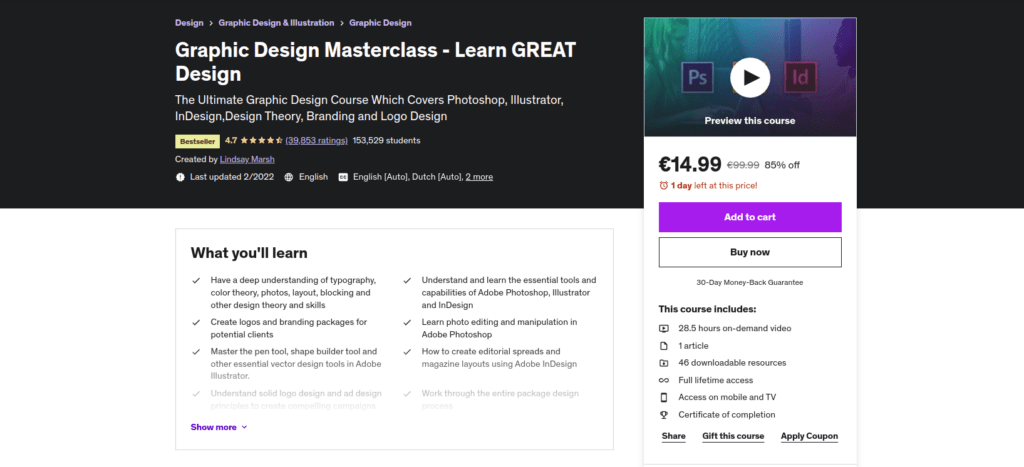
Graphic Design Masterclass – Learn GREAT Design is a comprehensive graphic design course by Udemy. This course is a bestseller and a one-of-a-kind course.
The course is for beginners who are looking to become professional graphic designers. After completing this course, you are a full-on graphic designer ready for a job or freelance gigs.
Even if you have some graphic design experience, this course can benefit you. With this course, you get a thorough refresher and get to advance your current skills.
The course couples graphic design theory with solving real-life problems. You will learn a bunch of graphic design essentials, such as layout theory, color, and balance for awesome designs. More about the learning objectives is below.
Throughout this course, you will work on a variety of projects. These projects involve photo manipulation, magazine layouts, branding, and logo design. You will work with industry-leading graphic design tools Adobe Photoshop, Illustrator, and InDesign.
This course comes with a bunch of crucial content related to graphic design. For instance, there is a dedicated section for design trends of today. In this section, you learn what is working right now in the graphic design space.
Another insightful part of the course is called “Finding Your Design Niche”. This part teaches you
- What are the different design categories
- What types of projects do they involve
- How to get started with each category
This makes it easier for you to choose a niche to dive into. The niches covered in this section include UI/UX design, branding & logo design, and social media design.
This course is kept up to date well. There is a bunch of content marked as “New” in the course. For instance, one of the new learning objectives of the course is to design effective Youtube thumbnails and social media graphics.
After completing the course, you get a certificate for your work.
| Rating | 4.7 |
| Students Enrolled | 153,529 |
| Certification | Yes |
| Paid | Yes |
| Content | 28.5 hours of on-demand video, 1 article, 46 downloadable resources |
| Instructor | Lindsay Marsh |
| Refund Policy | 30-Day Money-Back Guarantee |
Requirements
This course uses Adobe Software. Thus, you need to make sure to have access to:
- Adobe Photoshop
- Adobe Illustrator
- Adobe InDesign
Preferably, your Adobe Software should be CS6 or higher.
Alternatively, you can use Affinity software as well. But keep in mind the course is run on Adobe software!
What You Will Learn?
This zero-to-hero course teaches you graphic design skills from the ground up. Some of the key learning highlights of this course include:
- Typography, color theory, photos, layout, blocking, and much more
- Understand the industry-leading graphic design tools by Adobe
- Creating logos and branding
- Edit and manipulate photos with Photoshop
- Understanding the graphic design trends of today
- Package design
- Editorial spreads and magazine layouts
And much more.
Who Should Take This Course?
This course is for anyone who wants to create stunning graphic design and become a job-ready graphic designer.
You should take this course if you want to:
- Learn how to use Photoshop, Illustrator, InDesign
- Understand graphic design basics and apply them to real-world applications
- Learn branding and logo design
- Sharpen your existing graphic design skills
- Become a part-time or full-time graphic designer
2. Graphic Design Bootcamp: Photoshop, Illustrator, InDesign [Udemy]
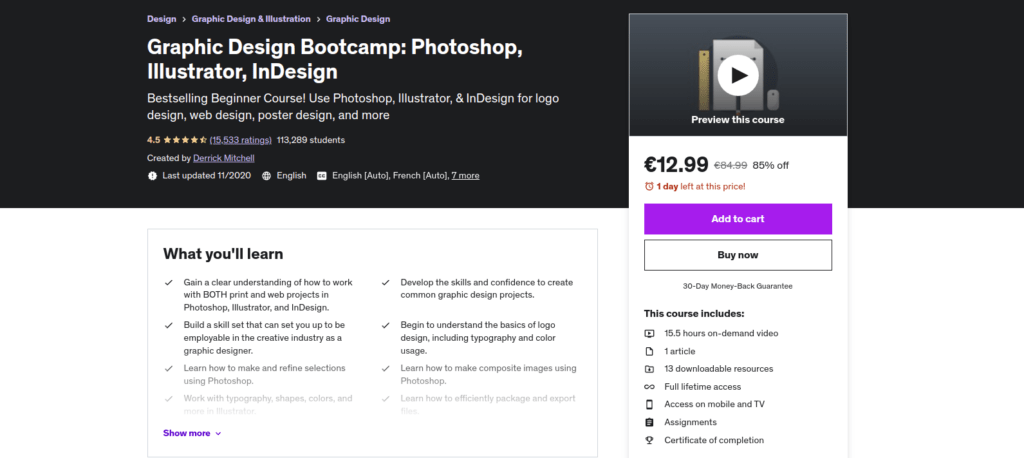
Graphic Design Bootcamp: Photoshop, Illustrator, InDesign is a highly rated graphic design course on Udemy. This course is taught by a popular teacher, Derrick Mitchell, who has almost two decades of working experience in graphic design.
If you are a graphic design first-timer, this is the course you should take!
After completing the course, you are a job-ready graphic designer in the creative industry. This course also suits those who are looking to become freelancers or entrepreneurs.
The main goal of this course is to turn learners into top-notch graphic designers with relevant skills and programs to create stunning designs.
The course is project-focused.
As a student, you get to work with some of the most common example projects in the graphic design space. You will design logos, business cards, web graphics, and much more.
Throughout this course, you will use Adobe software, that is, Photoshop, Illustrator, and InDesign.
The course instructor, Derrick Mitchell, has put together the lessons based on his two decades as a professional graphic designer. Thus, you get to learn exactly what is relevant in graphic design and Adobe’s tools. More importantly, you learn concepts and skills that the companies are looking for.
The design landscape changes quickly and so does the software. Derrick takes care of this as he regularly updates the course contents to match what is relevant today. As a part of this course, you get lifetime access to the course materials. Thus, you will always have an access to the most relevant information in the space.
After completing the course, you get a certification you can share with recruiters and add to your resume.
| Rating | 4.5 |
| Students Enrolled | 113,289 |
| Certification | Yes |
| Paid | Yes |
| Content | 15.5 hours of on-demand video, 1 article, 13 downloadable resources |
| Instructor | Derrick Mitchell |
| Refund Policy | 30-Day Money-Back Guarantee |
Requirements
To take this course, you don’t have to have any knowledge of graphic design.
Here is what you need to get started:
- Access to Adobe Photoshop, Illustrator, and InDesign
- Know how to use a computer even though no prior knowledge about Adobe’s software is required
- A desire to learn design
- It is not required but it helps to have some creative skills, such as drawing or photography
The instructor uses a Mac to teach the course. But you can still follow the course using Windows.
What You Will Learn?
You will learn a bunch of essential skills of a graphic designer. These include:
- Skills and confidence to create graphic design projects
- Understanding logo design
- Becoming an employable graphic designer
- Becoming proficient at using Adobe’s graphic design tools
- Typography, shapes, and colors in illustrator
- Composite images in Photoshop
- Exporting and packaging files efficiently
- Working with Illustrator-type tools
And much more.
Who Should Take This Course?
This is a beginner-friendly course that takes you from zero to a hero in graphic design.
You should take this course if you want to:
- Start a career as a graphic designer
- Become an entrepreneur or freelancer
- Turn your creative ideas into digital format in general
3. Adobe CC Masterclass: Photoshop, Illustrator, XD & InDesign [Udemy]
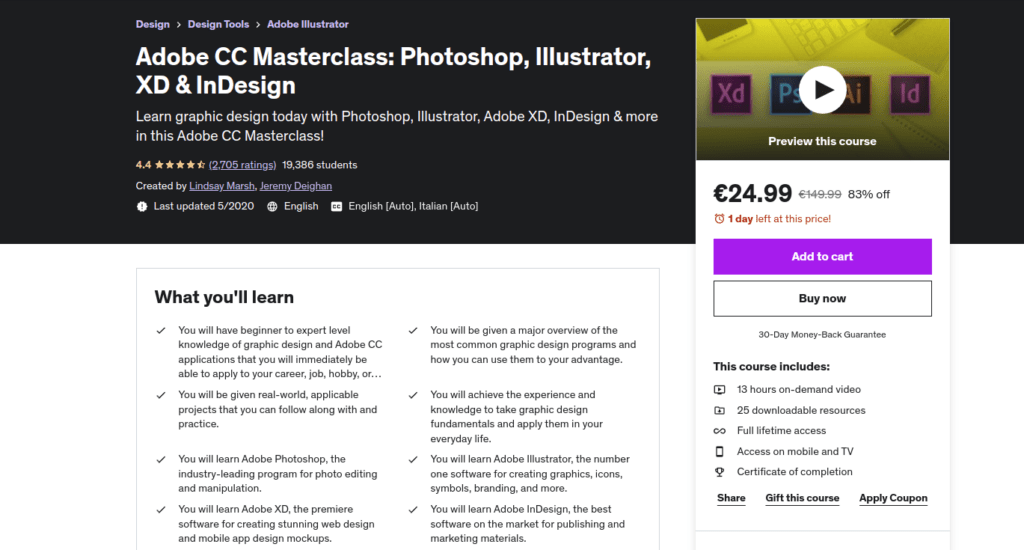
Adobe CC Masterclass: Photoshop, Illustrator, XD & InDesign is a complete graphic design course by Udemy.
This graphic design course teaches you how to use the Adobe CC programs, that is:
- Illustrator
- Photoshop
- XD
- InDesign
The course teaches you the basic theory and principles of graphic design. This course comes with a bunch of useful real-world design projects that you should follow and practice.
Even though this is a beginner-friendly course, it doesn’t mean advanced graphic designers wouldn’t benefit from it too! No matter whether you are a beginner, freelancer, or employee, you will certainly find a lot of useful topics and projects in this course. As an experienced designer, you can refresh and sharpen your skills with the help of this course.
This course is taught by Lindsay Marsh and Jeremy Deighan. These two combined have years of graphic design experience under their belts. In other words, they know what is relevant to learn to maximize career opportunities.
Students also get access to the course’s Facebook group. This way you get to connect with the instructors and other students and have a chance to:
- Ask questions
- Get feedback
- Participate in design challenges
After successfully completing the course, you get a shareable certification.
| Rating | 4.4 |
| Students Enrolled | 19,386 |
| Certification | Yes |
| Paid | Yes |
| Content | 13 hours of on-demand video, 25 downloadable resources |
| Instructor | Lindsay Marsh, Jeremy Deighan |
| Refund Policy | 30-Day Money-Back Guarantee |
Requirements
No previous graphic design experience is assumed. However, you need to have a computer and access to Adobe CC programs.
The course is currently taught using Adobe CC 2019 suite.
Get the most recent Adobe CC License here!
What You Will Learn?
The learning highlights of this course include:
- Expert-level knowledge of Adobe CC programs
- How to use graphic design programs
- Working with real-world graphic design projects
- Applying graphic design fundamentals in your everyday life
Who Should Take This Course?
This is a beginner-friendly course that teaches you proficient graphic design skills from the ground up.
You should take part in this course if you want to:
- Learn graphic design as a complete beginner
- Learn how to use Adobe CC programs
- If you are (or want to become) a:
- Graphic Designer
- Website Designer
- UI/UX Designer
- Product Designer
- T-Shirt Designer
4. Illustrator 2022 MasterClass [Udemy]
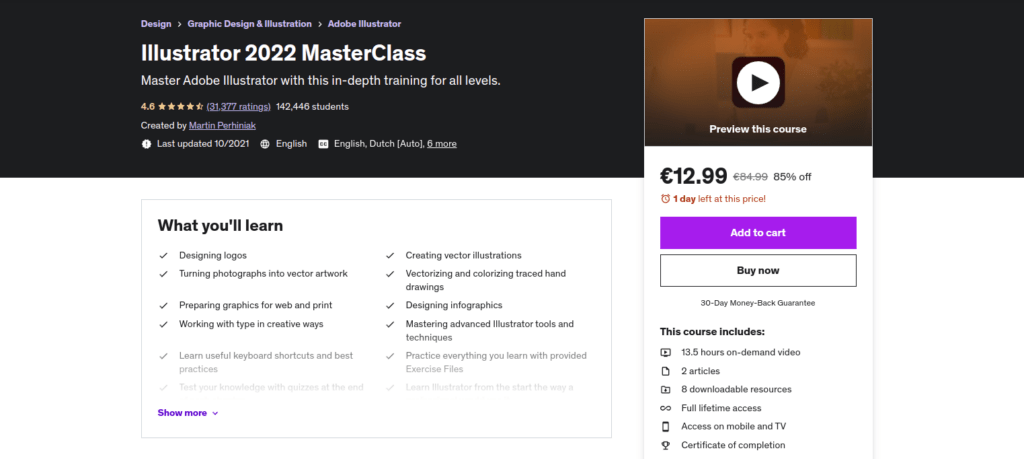
Illustrator 2022 MasterClass is a graphic design course that focuses on using Adobe Illustrator.
Unlike many other courses in this list, this particular course focuses on Adobe Illustrator only.
This course is a best-seller Illustrator course on Udemy. The course instructor, Martin Perhiniak, belongs to the Top 10 Adobe Instructors in the world. He has worked as a designer and illustrator for Disney, BBC, and Pixar.
The main goal of this course is to teach you how to use Adobe Illustrator professionally as a graphic designer.
The course teaches you different techniques in graphic design. The knowledge is tested using exercises and quizzes. The course content is well-crafted and solely focuses on skills you really need in the job market.
If you are new to Adobe Illustrator, it is the de-facto vector graphic software. Illustrator is not only used by graphic designers. It is a commonly used tool among product designers and UI/UX designers, for example.
This comprehensive Illustrator course benefits complete beginners as well as experienced graphic designers. As a beginner, you get a solid foundation in graphic design and using Illustrator. As an experienced designer, you get a great refresher, find hidden gems, and new workflows, and learn the overall new CC 2020 features.
This course comes with helpful video theory and downloadable project files that you can import straight to Illustrator. To test your knowledge, make sure to complete the quizzes at the end of the chapters!
After the course, you get a certification for your work.
| Rating | 4.6 |
| Students Enrolled | 142,446 |
| Certification | Yes |
| Paid | Yes |
| Content | 13.5 hours of on-demand video, 2 articles 8 downloadable resources |
| Instructor | Martin Perhiniak |
| Refund Policy | 30-Day Money-Back Guarantee |
Requirements
You don’t need to have any background in graphic design or use the design software.
However, to follow along and complete the projects, you need to have an Adobe Illustrator license. Any version will do but a version older than CS6 is not recommended.
You can get Adobe Illustrator here.
What You Will Learn?
This is a complete course in graphic design using Illustrator. Some of the key learning outcomes of the course are:
- Designing logos
- Creating vector graphics
- Turning hand drawings into vectorized and colorized assets
- Vectorizing photographs
- Useful workflows, best practices, and shortcuts on Illustrator
- How to design infographics
- Become an overall professional with Illustrator
Who Should Take This Course?
- This course is for anyone looking to get into the creative industry with a solid foundation in Adobe Illustrator.
- Even though this course is marketed for beginners, experienced designers find it useful too. This is because a lot of self-taught designers are missing out on important aspects! This course can be a skill-sharpener even for an experienced graphic designer.
5. Learn the Entire Affinity Suite: Photo, Designer & Publisher [Udemy]
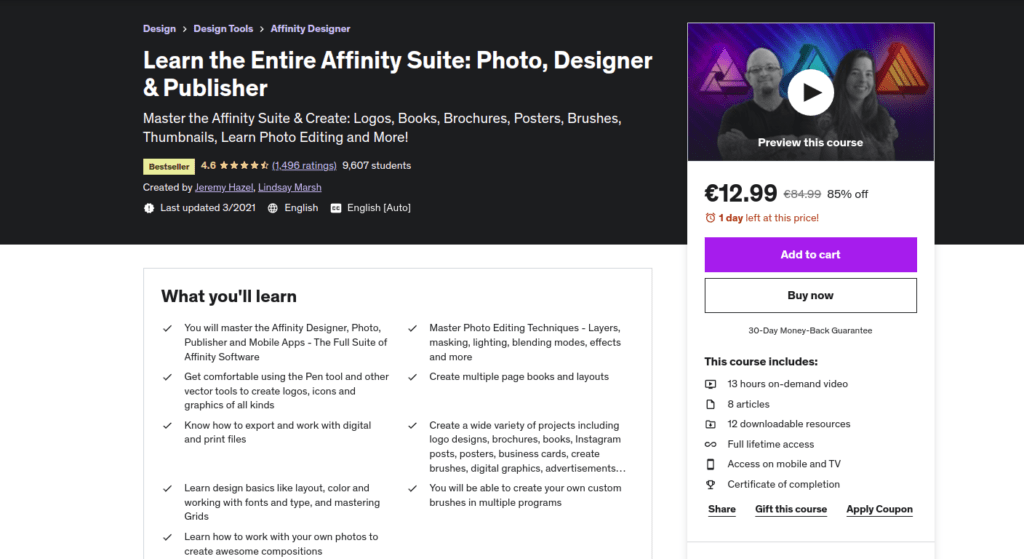
Learn the Entire Affinity Suite: Photo, Designer & Publisher is a complete course on Affinity graphic design tools.
Most of the courses in this list focus on the Adobe CC suite. However, if you are someone who wants to work with Affinity software, this is the right course for you.
If you are a beginner interested in graphic design, this is a great course that turns you into a proficient graphic designer.
Throughout this course, you learn how to work with tools like:
- Affinity Photo
- Affinity Designer
- Affinity Publisher
- Affinity Mobile Apps
Thus, this course is also great for experts in the creative field who want to add Affinity software skills to their toolbelt.
The course is taught by top-notch designers in the field, Lindsay Marsh and Jeremy Hazel. These two have years of experience in the creative field. They have both worked as design professionals as well as design teachers.
The course comes with a bunch of useful example projects you get to work with. This way you get a hands-on experience in graphic design as well as the Affinity tools.
In one part of the course, you get to see how Jeremy Hazel uses Affinity Photo to design:
- Three popular advertisements
- Three Youtube thumbnails
- A movie poster
In another section, Lindsay Marsh uses Affinity Designer to walk through all the important tools and features by building a tracing worksheet. In this part, you learn how to use pen tools, shape tools, and how to create icons.
After the course, you get a certification for your work.
| Rating | 4.6 |
| Students Enrolled | 9,607 |
| Certification | Yes |
| Paid | Yes |
| Content | 13 hours of on-demand video, 8 articles, 12 downloadable resources |
| Instructor | Jeremy Hazel, Lindsay Marsh |
| Refund Policy | 30-Day Money-Back Guarantee |
Requirements
You don’t need previous knowledge in graphic design.
However, you need access to the Affinity Products, that is:
- Affinity Photo
- Affinity Designer
- Affinity Publisher
- Optional: Affinity Mobile Apps
In addition, you need a computer and a working internet connection.
What You Will Learn?
During this course, you learn the basics of graphic design and the full suite of Affinity software.
The key learning highlights in this course involve:
- Mastering photo editing techniques
- Creating multi-page books and layouts
- Using pen tool and other vector tools for logos, icons, and other common graphic types
- Exporting and working with digital and print files
- Learning the design basics, such as
- layout
- color
- fonts
- grids
And much more.
Who Should Take This Course?
This course is geared toward beginners eager to become professional graphic designers.
You should consider this course if you want to:
- Learn Affinity Suite instead of Adobe
- Learn the basics of graphic design with real-world projects
- Professional designers who lack Affinity knowledge
6. Learn Adobe Photoshop from Scratch [Udemy]
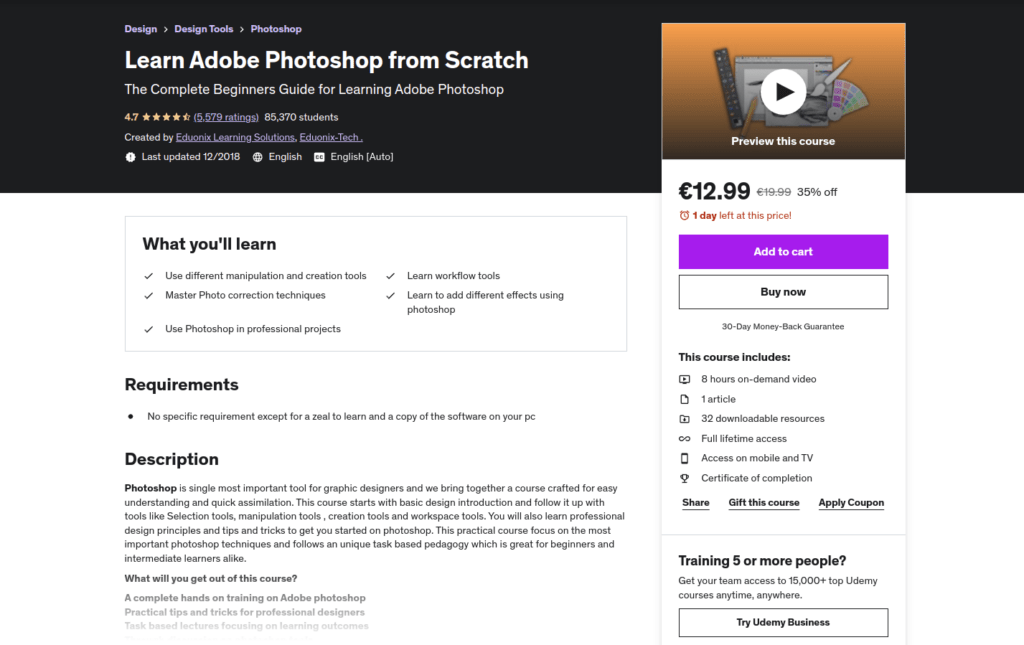
Learn Adobe Photoshop from Scratch is a Photoshop-oriented graphic design course. Not only do you learn the basics of graphic design but also how to use the ever-so-popular Adobe Photoshop software.
Adobe Photoshop is the de-facto software for photo editing. Photoshop has been around for years and its reputation is one of a kind. Most people associate Photoshop with editing images. But Photoshop is more than a photo editing tool. As a matter of fact, it is a great tool for graphic design.
This course focuses on graphic design using Adobe Photoshop.
The course is geared toward beginner designers who want to build a solid foundation in graphic design. This course also suits someone who is an experienced designer but wants to master Photoshop skills.
And no, this course is not all about theory. Instead, you should use Photoshop along the course on the real-life projects presented in the course.
The course starts with an introduction to design. If you have no previous knowledge of graphic design, this is a great primer. After the introduction, you start working on projects using Photoshop. You will learn how to use Selection Tools, Manipulation Tools, Creation Tools, and Workspace Tools.
In addition, you learn design workflows, principles, tips, and tricks that professionals use.
After completing the course, you get a nice certification for your work.
| Rating | 4.7 |
| Students Enrolled | 85,370 |
| Certification | Yes |
| Paid | Yes |
| Content | 8 hours of on-demand video, 1 article, 32 downloadable resources |
| Instructor | Eduonix Learning Solutions, Eduonix-Tech |
| Refund Policy | 30-Day Money-Back Guarantee |
Requirements
This course requires no previous knowledge of design or photo editing.
All you need is a computer with an internet connection and a license to Adobe Photoshop.
What You Will Learn?
You will learn how to use Photoshop to create stunning designs. Here are some key learnings of the course:
- Learning workflow tools
- Using manipulation tools
- Master photo-correcting techniques
- Use Photoshop in real-world projects
- Learn different Photoshop effects
Who Should Take This Course?
This course is for anyone who is looking to learn to use Photoshop from the ground up.
No previous design knowledge or Photoshop skills are needed.
7. Graphic Design Specialization [Coursera]
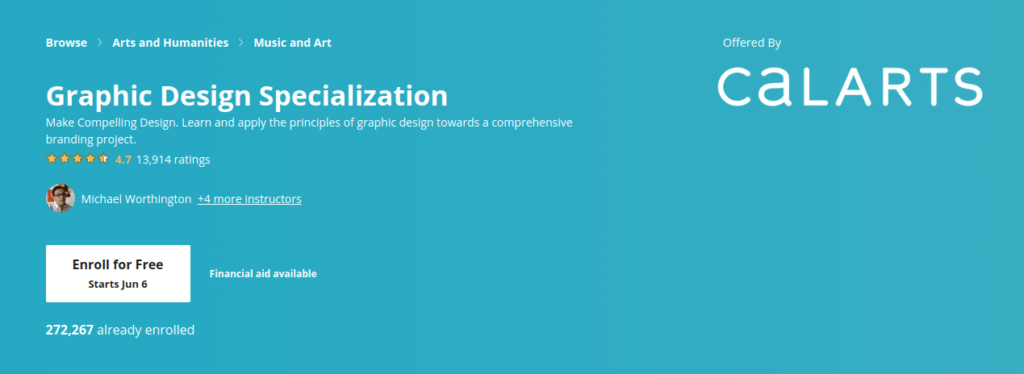
Graphic Design Specialization is a highly-rated comprehensive graphic design course designed by CalArts (California Institute of the Arts).
This is not a single course. Instead, it is an ensemble of 5 separate courses that relate to one another. Here are the courses that belong to the specialization:
- Fundamentals of Graphic Design.
- Introduction to Typography
- Introduction to Imagemaking
- Ideas from the History of Graphic Design
- Brand New Brand
Each course comes with a certificate upon completion.
Some of the courses that make up this specialization can be taken as standalone courses. However, the last course can only be taken once you have completed all the courses prior to that.
We will take a closer look at each individual course in a moment.
| Rating | 4.7 |
| Students Enrolled | 272,267 |
| Certification | Yes |
| Paid | Yes |
| Content | 5 related courses |
| Instructor | Michael Worthington |
| Refund Policy | 7-Day Free Trial |
Requirements
You don’t need any prior knowledge in design or using the design tools.
However, you need access to Adobe’s software:
- Adobe Photoshop
- Adobe Illustrator
- Adobe InDesign
What You Will Learn?
This specialization of 5 courses teaches you a lot about graphic design. Some of the key learning outcomes include:
- Having the fundamental skills of a professional graphic designer
- Learning how to communicate through image-making and typography
- A big final project you can add to your portfolio
- Learn how to work with:
- Interface Design
- Motion Graphics
- Editorial Design
Who Should Take This Course?
This specialization of 5 courses suits someone who is looking to become a job-ready graphic designer.
You should consider signing up if you want to:
- Learn how the entire design process works
- Become a job-ready designer
- Work with interface design, motion graphics, or editorial design
- Add a capstone project to your portfolio
Let’s have a look at the individual courses that make up the specialization.
Course 1/5: Fundamentals of Graphic Design
As the first course in the specialization, this course teaches you the fundamentals of graphic design. The theory is backed up with great visual examples.
In this course, you learn concepts like:
- Imagemaking
- Typography
- Composition
- Colors and shapes
And more.
Notice that watching tutorials and examples does not get you far. In addition, you have to get your hands dirty and build designs! This is why this course comes with a bunch of exercises and projects.
After completing this first course in the specialization, you can:
- Explore and investigate design through image-making techniques
- Work with shapes, colors, and patterns
- Understand the language and skills of typography
- Apply the principles of composition and visual contrast
All in all, this course teaches you the core concepts of graphic design. You can apply these skills to your own projects, or dive deeper into a particular area in graphic design.
Course 2/5: Introduction to Typography
Typography is an art form that focuses on manipulating the visual form of language to control its meaning. Typography is one of the foundational skills of a qualified graphic designer.
The second course of the specialization is a meticulous course on Typography. You will study, name, and measure the characteristics of letterforms. You will also take a closer look at the multicolored history of the most familiar typefaces to date.
You will learn best practices for choosing a type based on principles of hierarchy and spatial organization. In addition, you will explore the endless possibilities of type.
This course consists of informative lectures. To support the theory, you will complete a bunch of peer-assessed assignments. The final project of this course is to design a typographic poster.
Course 3/5: Introduction to Imagemaking
The third course in this specialization is an imagemaking course. The course is designed for students that are new to the concept of imagemaking.
In short, imagemaking is a graphic design area that stems from practice and process. Imagemaking involves:
- Fearless experimenting
- Sharing Ideas
- Giving constructive feedback
- Receiving constructive feedback
Because this is an online course, investigations are structured to some extent. But for the most part, imagemaking is loose and unstructured.
The idea of imagemaking is simple: You don’t become a graphic designer by watching videos or juggling with ideas in your head. You have to focus on making. This is what the course is all about.
More specifically, during this course, you will:
- Experiment with materials and techniques to create images for graphic design
- Learn “visual vocabulary” to expand your skills to make and talk about your work
- Learn how to create compositions by making, manipulating, and arranging images
Course 4/5: Ideas from the History of Graphic Design
The fourth course in this specialization focuses on the ideas from the rich history of graphic design.
The main focus of the course is on the four key periods in the history of Western design. You will understand why things look the way they do, and more importantly, how designers tackle problems in their work.
Overall, you will learn where modern-day design practices come from. You will understand what turned graphic design from an instrumental practice into the hybridized field it is today.
This course is based on the perspective of contemporary design. It aims to connect ideas that turned the design practices from the 1850s through the 1960s into the way designers work today.
During each week, there is a short quiz that tests your knowledge of concepts. In addition, you get a reflective assignment. This gives you a chance to analyze the questions designers ask themselves.
Course 5/5: Brand New Brand
The fifth and the last course of the specialization is a capstone project.
During this course, you put together all you have learned in the previous courses.
In this final project, you invent an imaginary start-up company and design and develop a brand for it.
The idea is to carefully walk through the entire process of graphic design from ideas to presentation.
8. Graphic Design Elements for Non-Designers Specialization [Coursera]
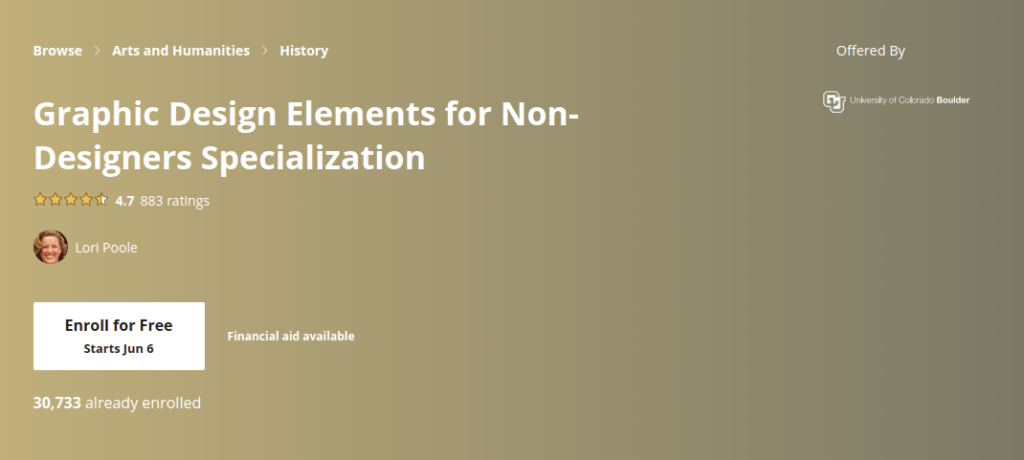
Graphic Design Elements for Non-Designers Specialization is a beginner-friendly graphic design specialization.
This specialization consists of four separate courses:
- Basic Elements of Design: Design Principles and Software Overview
- Graphic Elements of Design: Color Theory and Image Formats
- Textual Elements of Design: Fonts, Typography, and Spacing
- Print and Digital Elements of Design: Branding and User Experience
Each individual course gives you a certificate after completion.
We will take a closer look at each individual course in just a bit.
The main goal of this set of courses is to teach beginners the foundations of graphic design. You learn best practices, basic principles, and much more starting from brainstorming ideas.
After completing the specialization, you have the skills to independently work on design projects. For example, you can design ads, websites, brochures, and manuals.
| Rating | 4.7 |
| Students Enrolled | 30,733 |
| Certification | Yes |
| Paid | Yes |
| Content | 4 separate courses |
| Instructor | Lori Poole |
| Refund Policy | 7-Day Free Trial |
Requirements
This course requires a computer and an internet connection. Also, you need to have an access to the Adobe CC programs, such as Illustrator, Photoshop, and InDesign. You can get an Adobe CC License here.
What You Will Learn?
This course teaches you the basics of graphic design. Some key learning outcomes of this course include:
- Understand how design projects work
- Learn basic design concepts and apply them in the real world. These include
- Typography
- Color theory
- Image selection
- Layout best practices
- Learn how to work and communicate with creative professionals
- Design business cards, brochures, ads, websites, and manuals
Who Should Take This Course?
This course is for anyone interested in graphic design without previous knowledge of it.
This is a great first step toward a career as a graphic designer.
All you need is a desire to learn something new and a willingness to work on a bunch of design projects yourself.
Here is a more thorough look at the individual courses that make up the specialization.
Course 1/4: Basic Elements of Design: Design Principles and Software Overview
Although graphic design requires technical skills, it is not all about that. It is not enough to know how to use a program like Photoshop or Illustrator.
A graphic designer is a visual storyteller.
They are a person who puts together words, typography, and images to communicate info to a target audience.
A well-thought design touches feelings. It uses a proper tone to carry the news of today.
A website or brochure with a good design is inviting, easily understandable, and overall faster to process.
Graphic design is not all about making it look nice. It is all about content, layout, and more importantly, understanding the audience.
This course teaches you the foundational principles of graphic design. After completing the course, you know how to think like a designer.
Course 2/4: Graphic Elements of Design: Color Theory and Image Formats
The second course in the specialization focuses on different types of images and graphic elements.
You will start with the basics of color theory. You will understand what is the difference between the CMYK, Pantone, and RGB color spaces and how they are used.
After understanding the color spaces, you will explore the types of images used in print and digital projects.
Last but not least, you spend time looking at logo design. You will learn how to determine the best images and graphic elements for business branding case by case.
Course 3/4: Textual Elements of Design: Fonts, Typography, and Spacing
The third course in the specialization focuses on text.
Graphic design is all about telling a story with images and text.
This course teaches how to use textual elements in graphic design. This course teaches you about:
- The history of typography
- Difference between types
- Fonts and text
- Exposure to typography spacing
You learn how to pick the best kind of type and font combinations to deliver the message in a visually pleasing fashion.
Course 4/4: Print and Digital Elements of Design: Branding and User Experience
There are two ways to deliver a graphic design project:
- In a printed format
- In a digital format
This course teaches you how to create a design that works both in printed format and digital formats. For example, a design should look good in brochures and large prints. But at the same time, it should look professional on websites and social media.
You will also learn the basics of user experience (UX) and how to always keep the end result in mind when working.
9. Google UX Design Professional Certificate [Coursera]
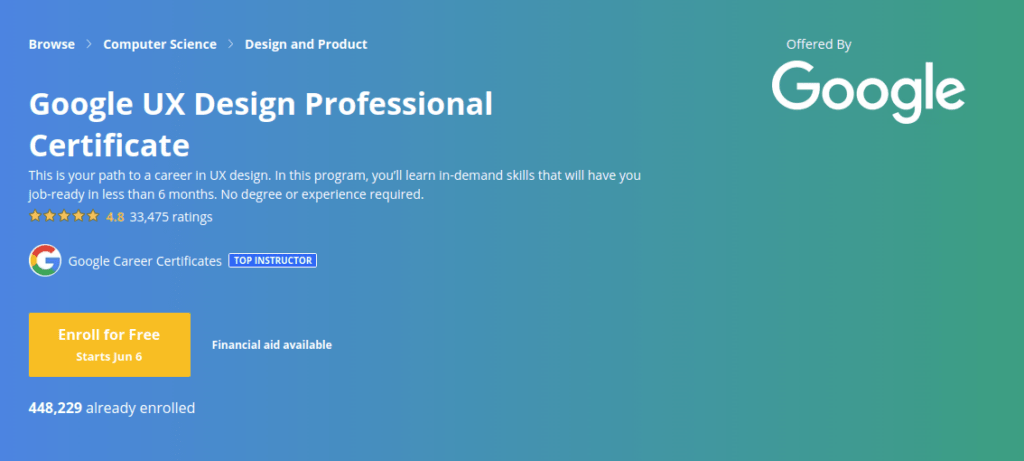
Google UX Design Professional Certificate is a UX designer’s go-to program that consists of 7 separate courses.
This certificate program prepares you for an entry-level design job as a UX designer.
This set of courses teaches you foundational knowledge in UX design. You will learn how to conduct successful user research. In addition, you learn how to create prototypes with industry-leading design software like Figma and Adobe XD.
By the way, feel free to read my best web design tools.
The courses that make up this specialization program are:
- Foundations of User Experience (UX) Design
- Start the UX Design Process: Empathize, Define, and Ideate
- Build Wireframes and Low-Fidelity Prototypes
- Conduct UX Research and Test Early Concepts
- Create High-Fidelity Designs and Prototypes in Figma
- Responsive Web Design in Adobe XD
- Design a User Experience for Social Good & Prepare for Jobs
Each course gives you a certificate after completion. You are going to find a detailed description of these courses below.
The program focuses on hands-on learning. The courses include articles, assessments, and hands-on projects.
When you complete the program, you have three awesome portfolio projects to share with recruiters. In addition, you have the skills to apply for jobs at companies like Google and other top employers like Deloitte, Walmart, and Best Buy.
| Rating | 4.8 |
| Students Enrolled | 448,229 |
| Certification | Yes |
| Paid | Yes |
| Content | 7 separate courses |
| Instructor | Google Career Certificates |
| Refund Policy | 7-Day Free Trial |
Requirements
To take the course, you need a computer and an internet connection.
In addition, you are going to use Adobe XD and Figma. Make sure to install and get a license to those before starting.
What You Will Learn?
This program turns you from zero to hero. You will learn the basics of UX design. The key learning outcomes of this course are:
- Following the design process
- Empathizing with the users
- Defining the user pain points
- Brainstorm solutions
- Create wireframes and prototypes
- Testing and iterating
- Understand how to conduct UX research
- Planning research studies
- User interviews
- Usability studies
- Analyzing and executing the research results
- Understanding the basic UX concepts
- User-centered design
- Accessibility
- Equity-focused design
- Create a nice UX portfolio with three outstanding projects
- Mobile app
- Website
- Cross-platform experience
And much more.
Who Should Take This Course?
Anyone who is looking for a comprehensive and versatile course on UX design should take this course.
If you want to become a job-ready UX designer, this is the course to take.
Also, if you are an existing graphic designer looking to sharpen your skills, this is the path to victory!
Course 1/7: Foundations of User Experience (UX) Design
The first course in the series of seven courses is a deep dive into the basics of UX design.
This course equips you with the basic skills of a UX designer. This is the first major step in becoming an entry-level job-ready UX designer.
In general, UX designers pay attention to how users interact with websites, apps, and physical objects. A successful UX designer makes those interactions smooth, enjoyable, and accessible.
As an entry-level UX designer, your job might be to focus on:
- Empathizing with users
- Specifying user pain points
- Brainstorming ideas to solve the problems
- Wireframing, prototyping, and creating mockups
- Testing and iterating
This course is taught to you by the leading UX design experts in the field that work for Google. These people certainly know what they are doing and what you should focus on. The learning happens via hands-on projects. These projects resemble real-life UX design projects.
Course 2/7: Start the UX Design Process: Empathize, Define, and Ideate
The second course in the UX design certification program teaches you how to start the UX design process
You will complete the first phases of the design process for one of the main projects of this program. You can include this project in your portfolio later on.
This course focuses on the previously mentioned important UX design aspects. These include:
- Empathizing with users
- Understanding pain points
- Defining user needs
- Come up with ideas for solutions
Course 3/7: Build Wireframes and Low-Fidelity Prototypes
In the third course, you will continue to design a mobile app for your UX portfolio.
You will start the design process of the app by creating storyboards and getting familiar with the basics of drawing.
Then, you will create paper wireframes after which you put together digital wireframes with the leading design tool Figma.
After wireframing comes the prototyping phase of the project. You will create a paper prototype as well as a low-fidelity prototype using Figma.
After completing this course, you can:
- Define a goal statement
- Create two types of storyboards
- big picture
- close-up
- Know what is the difference between low-fidelity and high-fidelity design
- Have basic drawing skills
- Organize mobile apps based on information architecture principles
- Create paper wireframes and prototypes for mobile apps
- Create digital wireframes and prototypes in Figma
- Design a low-fidelity prototype in Figma
- Recognize implicit bias and deceptive patterns in design
Course 4/7: Conduct UX Research and Test Early Concepts
The fourth course in this program teaches you how to plan and conduct a usability study. A usability study is useful as it helps you gather feedback about the UX designs.
After conducting a successful study, you will modify your low-fidelity designs based on the research results.
After completing this course, you can:
- Plan a successful and thorough user study
- Respect privacy and user data
- Conduct a successful usability study
- Take notes during a usability study
- Analyze usability study data
- Come up with insights based on the research data and analysis
- Present your findings in an insightful and accessible manner
- Modify low-fidelity designs according to what the study suggests
Course 5/7: Create High-Fidelity Designs and Prototypes in Figma
The fifth course in the specialization is a step-by-step tutorial that teaches you how to create high-fidelity designs. You will create these designs in Figma, which is a popular UX design software.
After creating the designs, you will turn them into an interactive prototype. This prototype should work as a finished product. You will then conduct research to gather feedback about the designs to make improvements. Last but not least, you learn how to effectively share the designs with development teams.
After this course, you can
- Create mockups and high-fidelity prototypes using Figma
- Understand and use the visual design elements and principles
- Organize, standardize, and improve your UX designs
- Take part in design critique sessions and feedback while iterating on designs
- Hand out completed design projects to the engineering team you are working with
Course 6/7: Responsive Web Design in Adobe XD
The sixth course in the certification series teaches how to create responsive web design using Adobe XD.
Your main focus in this course is on designing a responsive website using Adobe XD.
This is a complete UX design process from start to end. You start by empathizing with users, defining their pain points, and coming up with ideas to fix the problems. Then you continue in creating wireframes and prototypes, and test designs to get feedback. As an end result, you have a nice design project to add to your UX portfolio.
In other words, this course heavily depends on what you have learned in the previous courses in this series.
After completing this course, you can:
- Go through the entire UX design process independently
- Use the popular UX tool Adobe XD
- Plan information architecture and sitemaps for a website
- Create common layouts for web pages
- Perform an effective usability study
- Iterate on designs
- Create or update a UX-focused resume (Optional)
- Learn how to search for and apply to introductory-level jobs in the field of UX (Optional)
Course 7/7: Design a User Experience for Social Good & Prepare for Jobs
The last course in this certification series is a concluding course that prepares you for your entry-level UX job.
In this course, you design a dedicated mobile app. In addition, you also create a website for the app.
It is not a surprise that this is the time when you combine everything you have learned so far. Once again, you start by empathizing with users and identifying their pain points. Then you brainstorm a bunch of ideas and create wireframes and prototypes. You also research, test, and iterate the designs to help get them into their final format.
This course adds a third and final UX project to your professional portfolio.
After completing this course, you can
- Create a UX design from start to finish
- Make a distinction between dedicated mobile apps and a responsive web app
- Understand cross-platform UX design with progressive enhancement and graceful degradation principles
- Build wireframes and mockups with Adobe XD
- Create a UX project portfolio for job applications
- Join UX communities
- Interview for an entry-level UX design job
- Determine whether you should apply for a job or become a freelancer
Conclusion
That is a whole bunch of graphic design courses.
To recap, the courses introduced in this list are all beginner-friendly courses that assume no previous knowledge. All you need is a computer and an internet connection. However, none of these courses provide you with design software. This is what you need to take care of yourself.
The courses in this list can be split into the following categories:
- Comprehensive courses in graphic design
- Software-specific courses that teach you how to design with a particular tool
- Multi-course certification programs that make you a job-ready graphic designer or UX designer
None of these courses turn you into a success story overnight. Instead, most of the courses require months of work by working a couple of hours every week.
No matter which course you decide to participate in, remember to focus on making! Watching the tutorials is cool. Reading the articles is insightful. But the truly challenging part is to actually get your hands dirty. Working with actual projects is your only way to success.
Thanks for reading!
I hope you were able to find something that suits you the best.